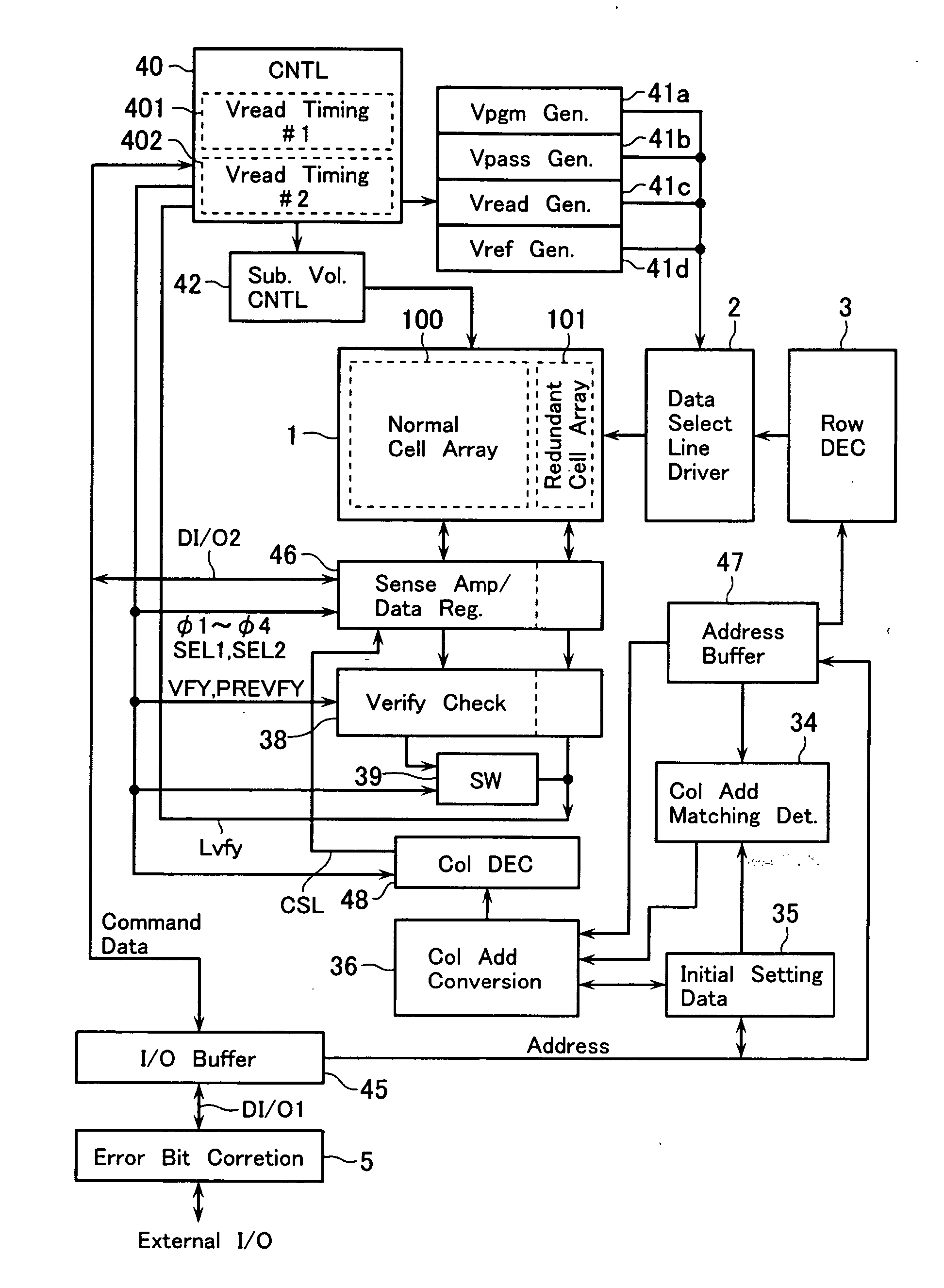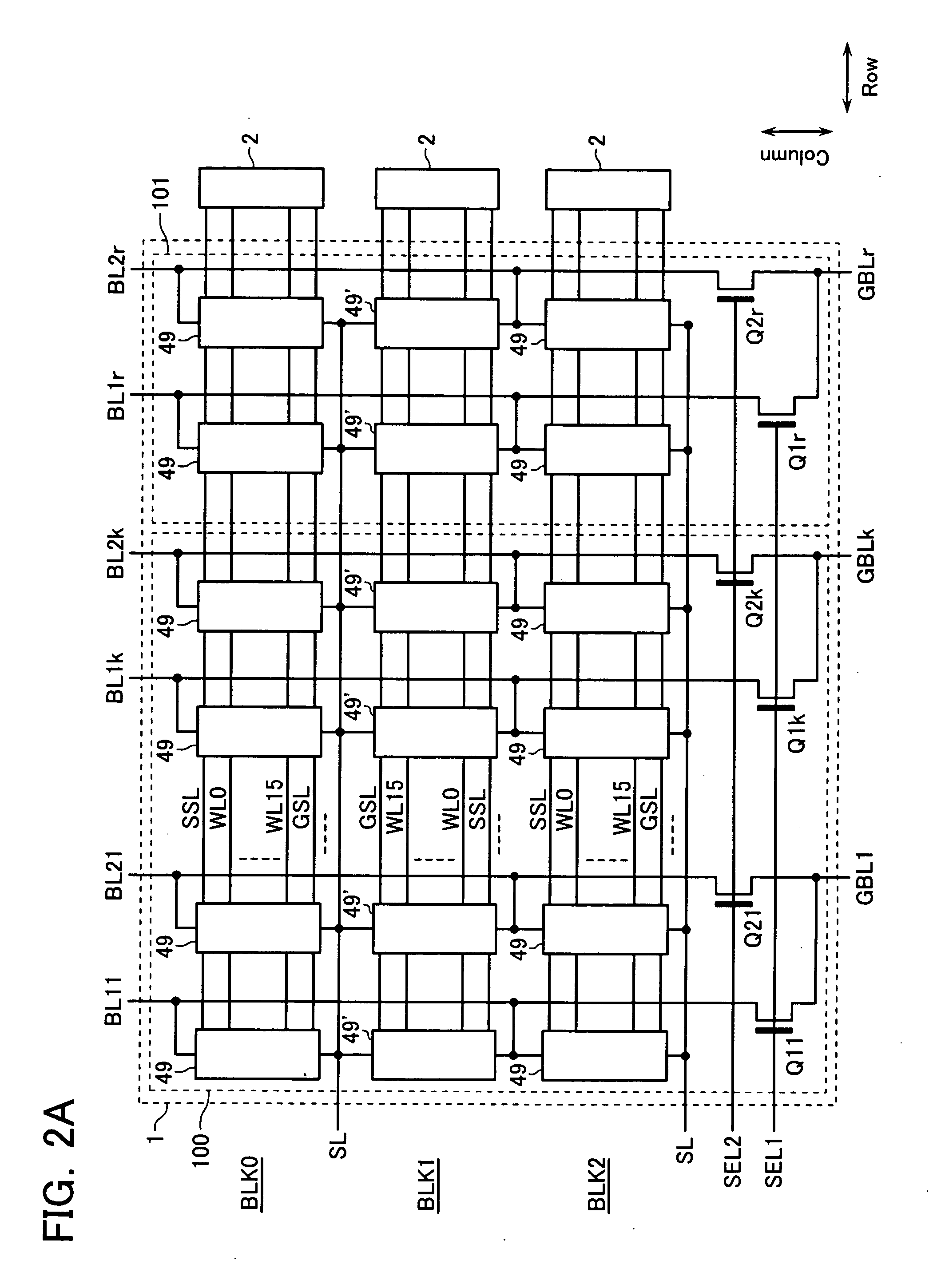Semiconductor memory device
a semiconductor and memory device technology, applied in the direction of redundant data error correction, fault response, instruments, etc., can solve the problems of increasing the delay of voltage signal transmission on such on-chip lead wires, requiring a longer read cycle time, and increasing the “wire delay”
- Summary
- Abstract
- Description
- Claims
- Application Information
AI Technical Summary
Benefits of technology
Problems solved by technology
Method used
Image
Examples
embodiment 1
[0071]FIG. 1 illustrates, in functional block form, an internal configuration of an electrically erasable programmable read-only memory (EEPROM) chip in accordance with an embodiment of the invention.
[0072] The illustrative EEPROM includes a memory cell array 1. The memory cell array 1 has a main cell array 100 which is referred to as a “normal data area” (first area) for storing therein the data as given from external input terminals I / O. The memory cell array 1 also has a redundant cell array 101 which is used as a “redundant area” (second area). The redundant cell array 101 is laid out on one end side of the normal cell array 100 along the row direction—that is, at a specific location in close proximity to a data select line driver 2 which drives data select lines of the memory cell array 1.
[0073] In the case of this embodiment, the redundant cell array 101 is a “redundant area” for use as a spare column cell area used for replacement of a column of the normal cell array 100 wh...
embodiment 2
[0174] Turning to FIG. 13, an EEPROM chip in accordance with an embodiment 2 of the invention is shown in a functional block form. The same parts or components and the same voltages to those of the embodiment 1 stated supra are denoted by the same reference characters, with detailed explanations thereof eliminated herein. In this embodiment, the column address conversion circuit 36 for performing defective column replacement additionally has therein specific logical / physical column address functionality, which exchanges or “interchanges” the order of sequence of at least part of physical column addresses to be sequentially selected by logical column addresses. With this built-in functionality of the column address converter circuit 36, it becomes possible to finally output the data of a specified storage area which is in the middle of a series of columns, when consecutively outputting data bits of multiple columns within the memory cell array 1. These functions will be explained in ...
embodiment 3
[0220]FIG. 22 shows a functional block configuration of an EEPROM in accordance with an embodiment 3 of the invention. FIG. 23A shows a configuration of a memory cell array 1, while FIG. 23B shows internal configurations of a sense amplifier circuit 46 and verify check circuit 38. Parts or components corresponding to those of the embodiments 1-2 stated supra are designated by the same reference characters with detailed explanations thereof eliminated herein. In this embodiment a column decoder circuit 48 is arranged to include therein a logical / physical column address conversion circuit added thereto. The logical / physical column address conversion function as used herein is for causing a certain redundancy cell array adjacent to data select line driver 2a, 2b to be last selected under a condition determined by the relationship in layout between a memory cell array 1 and data select line driver 2a, 2b. In brief, the logical / physical column address conversion function added to column ...
PUM
 Login to View More
Login to View More Abstract
Description
Claims
Application Information
 Login to View More
Login to View More - R&D
- Intellectual Property
- Life Sciences
- Materials
- Tech Scout
- Unparalleled Data Quality
- Higher Quality Content
- 60% Fewer Hallucinations
Browse by: Latest US Patents, China's latest patents, Technical Efficacy Thesaurus, Application Domain, Technology Topic, Popular Technical Reports.
© 2025 PatSnap. All rights reserved.Legal|Privacy policy|Modern Slavery Act Transparency Statement|Sitemap|About US| Contact US: help@patsnap.com



